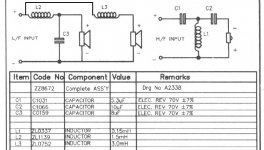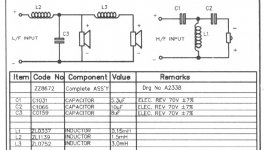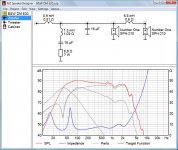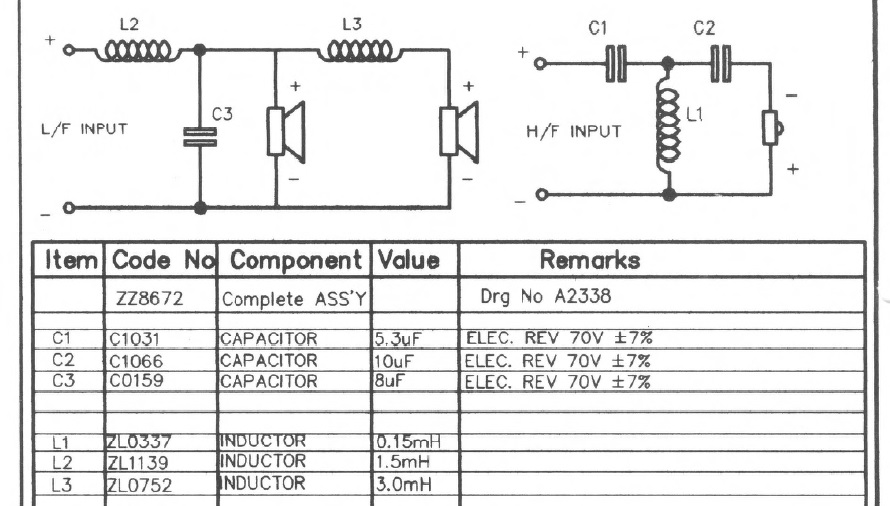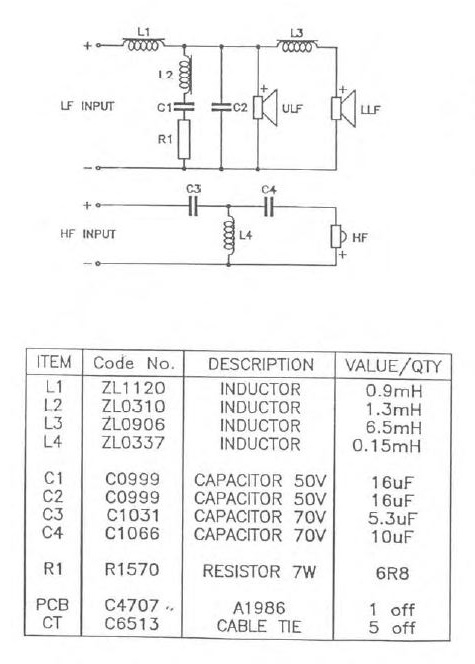Difference between the 2 2.5-way crossover
As I understood:
Version 1: The left woofer got a 12db/octave 2nd order by the L2, C3 and the right side woofer got a 6db/octave L3 1st order filter and the woofers work independently from each other? Am I right?
Version 2: If the L3 coil wasn' there both woofer would get the 12db/octave filter. But what happen if we put the L3 coil there? This I don't understand...and how can we get here 3Khz for the left and 400Hz crossover points for the right woofer?
Thanks.
Karoly
As I understood:
Version 1: The left woofer got a 12db/octave 2nd order by the L2, C3 and the right side woofer got a 6db/octave L3 1st order filter and the woofers work independently from each other? Am I right?
Version 2: If the L3 coil wasn' there both woofer would get the 12db/octave filter. But what happen if we put the L3 coil there? This I don't understand...and how can we get here 3Khz for the left and 400Hz crossover points for the right woofer?
Thanks.
Karoly
Attachments
Following on from my dumb post earlier( not reading the thread through) I found this series 2.5 way schematic. Re bsc how would it differ ? http://www.lcaudio.com/index.php?page=26
Following on from my dumb post earlier( not reading the thread through) I found this series 2.5 way schematic. Re bsc how would it differ ? L C Audio Technology / Series Filter
In that case, the .5 way is parallel and should give a full 6 dB, while the 2 way is series. Kind of the opposite of what I did. I could get more BSC with just a bigger inductor, as usual.
Hello Steve
Thank you very much for the detailed specification. My friend John will be so happy for that.
What is the recommendation here to change? Capacitors at the tweeter fx.?
I haven't heard the speaker yet. Next Saturday we will visit John and I can tell more.
Regards,
Karoly
So how was it on audition, Karoly? Quite bassy and boomy, I suspect. But, hey, I could be wrong.
As I understood:
Version 1: The left woofer got a 12db/octave 2nd order by the L2, C3 and the right side woofer got a 6db/octave L3 1st order filter and the woofers work independently from each other? Am I right?
Version 2: If the L3 coil wasn' there both woofer would get the 12db/octave filter. But what happen if we put the L3 coil there? This I don't understand...and how can we get here 3Khz for the left and 400Hz crossover points for the right woofer?
Thanks.
Karoly
I believe the 2nd pic is called a cascaded 2.5 way. The theoretical problem with X.5 ways is that rolling off the .5 driver will cause it to deviate in phase from the other woofer. Personally, never heard that as an actual problem probably because it is rolled off by the time the phase difference becomes significant.
Not quite correct:I'd love to know how.
Double the drivers, gain 3 dB,
Double the impedance, deliver ½ the power, lose 3dB.
Net gain, 0 dB.
dave
Double the drivers (hooking two identical drivers in parallel to an amp vs. just having a single driver) = +6dB
Wiring drivers in series = 1/2 the voltage per driver = 1/4 the power per driver = -6dB on each driver.
Total = +6 -6 = 0db.
It still serves the purpose of creating baffle step by attenuating the midrange 6dB compared to the bass and if wiring two 4ohm woofers in series you still get +3dB overall sensitivity compared to a single 8ohm woofer because you're putting the same amount of power into twice the cone area.
The effect of the phase shift of the 0.5way/BSC woofer in a 2.5way setup is that the listening axis is tilted down from horizontal assuming you place the BSC woofer below the other one. I.e. If you have your speakers mounted at ear height when sitting in a chair, then when you stand up a recession will appear in the upper midrange. This is because by standing up the BSC woofer gets even further away from your ears than the other drivers and in the upper midrange it's phase starts to approach 180degrees and partially cancel with the other drivers. The opposite is true if you place the BSC woofer at the top - listening axis is tilted up from horizontal. Obviously it gets worse the lower your 2-way crossover point is and the higher your baffle step compensation needs to be so slim cabinets with a low tweeter XO point are the most affected.I believe the 2nd pic is called a cascaded 2.5 way. The theoretical problem with X.5 ways is that rolling off the .5 driver will cause it to deviate in phase from the other woofer. Personally, never heard that as an actual problem probably because it is rolled off by the time the phase difference becomes significant.
Actually no because the inductor on the 0.5w/BSC woofer will make that woofer much greater than 8ohm at and above the frequency that the 12dB/oct filter starts to roll off so the 12db/oct filter will only see slightly less than 8ohm, maybe 7ohm or so... Basically, the best way is to just simulate it.It means the 12db/oct filter has to be calculated for 4 ohm impedance and for the other woofer that I want to slopes down much lower in frequency with 6 dB/oct (1st order) need calculation for 8 ohm?
Last edited:
Wiring drivers in series = 1/2 the voltage per driver = 1/4 the power per driver = -6dB on each driver.
Total = +6 -6 = 0db.
It still serves the purpose of creating baffle step by attenuating the midrange 6dB compared to the bass and if wiring two 4ohm woofers in series you still get +3dB overall sensitivity compared to a single 8ohm woofer because you're putting the same amount of power into twice the cone area.
So potentially you do see a +3 BSC ?
Which is about right for most rooms
Not quite correct:
Double the drivers (hooking two identical drivers in parallel to an amp vs. just having a single driver) = +6dB
That is the net for parallel. But it is from +3 dB for 2 drivers. +3 dB as you are drawing 2x the power vrs 1 driver. 6 dB only comes as the total of the 2.
Series is +3 dB for 2 drivers. -3 dB as you are drawing 1/2 the power of a single driver.
-6dB vrs 2 drivers in parallel, but that is not the starting point.
dave
I lstened with John both the B&W DM-630 where the bottom woofer only goes til 160Hz and also the DM-630i version where the bottom woofer goes until 400Hz. The 160Hz version: the vocal a bit narrow, the bass is not strong enough, missing the pounchy, the tweeter looks so much, too much by quantity.
The 400Hz version: Much tighter bass, full bodied vocal, optimal tweeter, has a huge ambient, big soundstage. The bass not pounchy at all, optimum level. All the frequency is perfect and fantastic to listen to it, I got a shock how very 3 dimensional.
Somebody has to listen to it, highly reecommended!!!!!!!
The 400Hz version: Much tighter bass, full bodied vocal, optimal tweeter, has a huge ambient, big soundstage. The bass not pounchy at all, optimum level. All the frequency is perfect and fantastic to listen to it, I got a shock how very 3 dimensional.
Somebody has to listen to it, highly reecommended!!!!!!!
Ahh I reread your post and see your way of thinking now. You're thinking in power and I'm thinking in voltage per driverSeries is +3 dB for 2 drivers. -3 dB as you are drawing 1/2 the power of a single driver.
Do you mean for the circuit in post #5? That one won't give any baffle step. The purpose is that the two drivers share the work of producing the bass which has the effect of lowering cone excursion and therefore distortion. At high frequency the capacitor bypasses one of the drivers and the other driver does work at full power. So it transitions from two woofers in series to just one woofer with the other shorted.So potentially you do see a +3 BSC ?
Which is about right for most rooms
If you want baffle step in series config you need something like this:
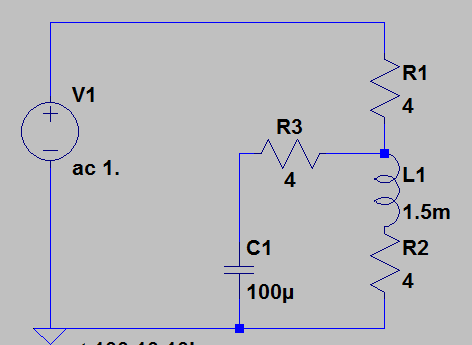
R1 and R2 represent nominal 4ohm woofers. R3 sets the amount of baffle step. If R3=R1=R2 you get +6dB bsc. If you lower the value of R3 then driver R1 plays louder in the treble achieving a smaller amount of BSC. C1/L1 need to be adjusted to achieve smooth frequency response after changing R3.
Honestly the only case I'd consider using a topology like this is if I wanted to use a pair of 4ohm woofers and needed the design to be nominal 8ohm at bass frequencies. Anything less than full BSC and the impedance will still head towards nominal 4ohm at higher frequencies however.
Last edited:
Yes
Really is a wonderful speaker, I cannot believe it how it sounds. I have an old Pioneer CS-R500 although I updated with air coils, Jantzen Superior Z-Caps, Jantzen Superes resistors, new midrange, new soft dome tweeter, etc. and the sound improved a lot, although still behind this B&W DM-630i. How, I really don't know. The DM-630i has the original crossover from 1993 and the capacitors are simple BENNIC electrolyt bipolars...I don't know what is the magic in these speakers, but really has magic sound...I never heard a speaker with a big soundstage like this.
Really is a wonderful speaker, I cannot believe it how it sounds. I have an old Pioneer CS-R500 although I updated with air coils, Jantzen Superior Z-Caps, Jantzen Superes resistors, new midrange, new soft dome tweeter, etc. and the sound improved a lot, although still behind this B&W DM-630i. How, I really don't know. The DM-630i has the original crossover from 1993 and the capacitors are simple BENNIC electrolyt bipolars...I don't know what is the magic in these speakers, but really has magic sound...I never heard a speaker with a big soundstage like this.
Yes these are thank you.
We think that absolute they are the same woofers. Only thing is that the foam design around the cone is different on the top surface nothing more, it means are the same.
Can you tell me that the L3 coil influence the left side woofer in sound or not?
If yes, how? I mean in the 630i version. Thank you.
We think that absolute they are the same woofers. Only thing is that the foam design around the cone is different on the top surface nothing more, it means are the same.
Can you tell me that the L3 coil influence the left side woofer in sound or not?
If yes, how? I mean in the 630i version. Thank you.
Ahh I reread your post and see your way of thinking now. You're thinking in power and I'm thinking in voltage per driver
Less in power and more in SPL (same kind of dBs as power) since we ar etalking about loudness.
dave
Yes these are thank you.
We think that absolute they are the same woofers. Only thing is that the foam design around the cone is different on the top surface nothing more, it means are the same.
Can you tell me that the L3 coil influence the left side woofer in sound or not?
If yes, how? I mean in the 630i version. Thank you.
You could take L3 (3mH) out altogether on the 630i. You then get a slightly louder 400Hz to 3kHz, but hardly a biggie. Perhaps L2 should then be about 2mH for the same balance. But the woofers are then working together for the big PA farfield projection that characterises doubled woofers.
I upgraded our vintage Pioneer CS-R500 speaker's tweeter. The original was a horn-type that was terrible harsh and edgy sound. The new is a soft dome called Monacor DT-254 8ohm. At this moment the crossover frequency is around 3,8Khz roughly. Here I made many experiments with values of the air coils diameter and caps. The 2nd order filter values are 0.35mH 3.3uF
The interesting things are:
- Dia 1mm wire air coil has edgy, sharp sound
- Dia 0.8mm smoother than before
- Dia 0.5mm has the smoothest sound (here I talk small differences, but can be heard)
After I was also playing with the air-coil values between 0.35mH-0.5mH and this time I kept the capacitor on fix 3,3uF. First the two borderline:
- 0.35mH the treble is terribble edgy and too thin, not possible to listen
- 0,5mH the treble is extremely smooth, but thick, and shows a lot lower treble, seems to lost dynamic as well, "too lazy, elongated"
- 0.39mH was still edgy, like with the 0.35mH but smoother at the same time
- 0.47mH is the optimal sound. Smooth and has dynamic at the same time, fx. when a cymbal is running in the jazz music or something like that. Very friendly for the ears.
The capacitors:
- Jantzen Cross-Cap 3,3uF. The sound is edgy, but better than an electrolyt, nothing special.
- Mundorf MCap EVO Oil 3,3uF unbelievable, the sound is the smoothest and fantastic to listen to it, lack of informations a bit, but nice overall
- Jantzen Superior Z-Cap 3,3uF Very smooth, but here emphasize the upper treble a bit, but has strong 3 dimensional effect, so for this reason I chose them.
My question is that somebody also had such an experiment especially at the tweeter, like changing coil values and check how is the effect of the sound?
I think its tricky to get the smoothest sound from a tweeter even if its soft dome, because the human ear is sensitive for such a frequency spectrum. My other question is that better to built a 3rd order filter here or definitely will not improve anything? Thanks.
The interesting things are:
- Dia 1mm wire air coil has edgy, sharp sound
- Dia 0.8mm smoother than before
- Dia 0.5mm has the smoothest sound (here I talk small differences, but can be heard)
After I was also playing with the air-coil values between 0.35mH-0.5mH and this time I kept the capacitor on fix 3,3uF. First the two borderline:
- 0.35mH the treble is terribble edgy and too thin, not possible to listen
- 0,5mH the treble is extremely smooth, but thick, and shows a lot lower treble, seems to lost dynamic as well, "too lazy, elongated"
- 0.39mH was still edgy, like with the 0.35mH but smoother at the same time
- 0.47mH is the optimal sound. Smooth and has dynamic at the same time, fx. when a cymbal is running in the jazz music or something like that. Very friendly for the ears.
The capacitors:
- Jantzen Cross-Cap 3,3uF. The sound is edgy, but better than an electrolyt, nothing special.
- Mundorf MCap EVO Oil 3,3uF unbelievable, the sound is the smoothest and fantastic to listen to it, lack of informations a bit, but nice overall
- Jantzen Superior Z-Cap 3,3uF Very smooth, but here emphasize the upper treble a bit, but has strong 3 dimensional effect, so for this reason I chose them.
My question is that somebody also had such an experiment especially at the tweeter, like changing coil values and check how is the effect of the sound?
I think its tricky to get the smoothest sound from a tweeter even if its soft dome, because the human ear is sensitive for such a frequency spectrum. My other question is that better to built a 3rd order filter here or definitely will not improve anything? Thanks.
- Status
- This old topic is closed. If you want to reopen this topic, contact a moderator using the "Report Post" button.
- Home
- Loudspeakers
- Multi-Way
- 2.5 way crossover how it works?
